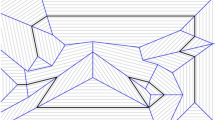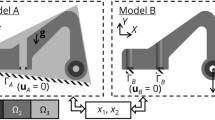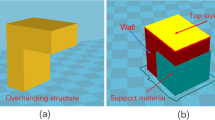Abstract
Continuous 3+2-axis additive manufacturing (AM) is an emerging AM technology that overcomes the signature problems of the need of support structures and the staircase effect of the traditional 3-axis AM. This paper presents a novel process planning framework for automatically generating a multi-axis support-free printing path for continuous 3+2-axis AM of an arbitrary freeform part. The framework is based on the geometric processing of skeletonization and decomposition and is particularly suitable for a part with distinct multiple trunk-branch structures. The physical printing experimental results carried out by the authors indicate that the proposed framework has performed well and fabricated some challenging models with large overhangs and twisty spatial topologies.



























Similar content being viewed by others
Change history
23 August 2020
The original published article contained a mistake.
References
W, H. C. (1984) Apparatus for production of three-dimensional objects by stereolithography. US Patent 4575330
Mirzendehdel AM, Suresh K (2016) Support structure constrained topology optimization for additive manufacturing. CAD Comput Aided Des 81:1–13. https://doi.org/10.1016/j.cad.2016.08.006
Garaigordobil A, Ansola R, Veguería E, Fernandez I (2019) Overhang constraint for topology optimization of self-supported compliant mechanisms considering additive manufacturing. CAD Comput Aided Des. 109:33–48. https://doi.org/10.1016/j.cad.2018.12.006
Ezair B, Massarwi F, Elber G (2015) Orientation analysis of 3D objects toward minimal support volume in 3D-printing. Comput Graph 51:117–124. https://doi.org/10.1016/j.cag.2015.05.009
Barari A, Kishawy HA, Kaji F, Elbestawi MA (2017) On the surface quality of additive manufactured parts. Int J Adv Manuf Technol 89(5–8):1969–1974. https://doi.org/10.1007/s00170-016-9215-y
Wulle F, Coupek D, Schäffner F, Verl A, Oberhofer F, Maier T (2017) Workpiece and machine design in additive manufacturing for multi-axis fused deposition modeling. Procedia CIRP 60:229–234. https://doi.org/10.1016/j.procir.2017.01.046
Tagliasacchi A, Delame T, Spagnuolo M, Amenta N, Telea A (2016) 3D skeletons: a state-of-the-art report. Comput Graph Forum 35(2):573–597. https://doi.org/10.1111/cgf.12865
Ventola CL (2014) Medical applications for 3D printing: current and projected uses. Pharm Ther 39(10): 704–11. https://www.ncbi.nlm.nih.gov/pmc/articles/PMC4189697/
Gao W, Zhang Y, Ramanujan D, Ramani K, Chen Y, Williams CB, Wang CCL, Shin YC, Zhang S, Zavattieri PD (2015) The status, challenges, and future of additive manufacturing in engineering. CAD Comput Aided Des 69:65–89. https://doi.org/10.1016/j.cad.2015.04.001
Chakraborty D, Aneesh Reddy B, Roy Choudhury A (2008) Extruder path generation for curved layer fused deposition modeling. CAD Comput Aided Des 40(2):235–243. https://doi.org/10.1016/j.cad.2007.10.014
Luo L, Baran I, Rusinkiewicz S, Matusik W (2012) Chopper: partitioning models into 3D-printable parts. ACM Trans Graph 31(6):1. https://doi.org/10.1145/2366145.2366148
Ding Y, Akbari M, Kovacevic R (2018) Process planning for laser wire-feed metal additive manufacturing system. Int J Adv Manuf Technol 95(1–4):355–365. https://doi.org/10.1007/s00170-017-1179-z
Keating S, Oxman N (2013) Compound fabrication: a multi-functional robotic platform for digital design and fabrication. Robot Comput Integr Manuf 29(6):439–448. https://doi.org/10.1016/j.rcim.2013.05.001
Wu C, Dai C, Fang G, Liu YJ, Wang CCL (2017) RoboFDM: a robotic system for support-free fabrication using FDM. Proc. - IEEE Int. Conf. Robot. Autom, pp 1175–1180. https://doi.org/10.1109/ICRA.2017.7989140
Dai C, Wang CCL, Wu C, Lefebvre S, Fang G, Liu YJ (2018) Support-free volume printing by multi-axis motion. ACM Trans Graph 37(4):1–14. https://doi.org/10.1145/3197517.3201342
Jiang X, Cheng X, Peng Q, Liang L, Dai N, Wei M, Cheng C (2017) Models partition for 3D printing objects using skeleton. Rapid Prototyp J 23(1):54–64. https://doi.org/10.1108/RPJ-07-2015-0091
Wei X, Qiu S, Zhu L, Feng R, Tian Y, Xi J, Zheng Y (2018) Toward support-free 3D printing: a skeletal approach for partitioning models. IEEE Trans Vis Comput Graph 24(10):2799–2812. https://doi.org/10.1109/TVCG.2017.2767047
Murtezaoglu Y, Plakhotnik D, Stautner M, Vaneker T, Van Houten FJ (2018) Geometry-based process planning for multi-axis support-free additive manufacturing. Procedia CIRP 78:73–78. https://doi.org/10.1016/j.procir.2018.08.175
Xu K, Chen L, Tang K (2019) Support-free layered process planning toward 3 + 2-axis additive manufacturing. IEEE Trans Autom Sci Eng 16(2):838–850. https://doi.org/10.1109/TASE.2018.2867230
Wu C, Dai C, Fang G, Liu YJ, Wang CCL (2020) General support-effective decomposition for multi-directional 3-D printing. IEEE Trans Autom Sci Eng 17(2):599–610. https://doi.org/10.1109/TASE.2019.2938219
Wang M, Zhang H, Hu Q, Liu D, Lammer H (2019) Research and implementation of a non-supporting 3D printing method based on 5-axis dynamic slice algorithm. Robot Comput Integr Manuf 57(January):496–505. https://doi.org/10.1016/j.rcim.2019.01.007
Luo N, Wang Q (2016) Fast slicing orientation determining and optimizing algorithm for least volumetric error in rapid prototyping. Int J Adv Manuf Technol 83(5–8):1297–1313. https://doi.org/10.1007/s00170-015-7571-7
Colding TH, Minicozzi WP, Pedersen EK (2015) Mean curvature flow. Bull Am Math Soc 52(2):297–333. https://doi.org/10.1090/S0273-0979-2015-01468-0
Tagliasacchi A, Alhashim I, Olson M, Zhang H (2012) Mean curvature skeletons. Eurograph Symp Geom Process 31(5):1735–1744. https://doi.org/10.1111/j.1467-8659.2012.03178.x
Chuang M, Kazhdan M (2011) Fast mean-curvature flow via finite-elements tracking. Eurograph Symp Geom Process 30(6):1750–1760. https://doi.org/10.1111/j.1467-8659.2011.01899.x
Shapira L, Shamir A, Cohen-Or D (2008) Consistent mesh partitioning and skeletonisation using the shape diameter function. Vis Comput 24(4):249–259. https://doi.org/10.1007/s00371-007-0197-5
Kovacic M, Guggeri F, Marras S, Scateni R (2010) Fast approximation of the shape diameter function. Proc Work Comput Graph Comput Vis Math 5(20). http://hdl.handle.net/11584/109583
Li X, Toon TW, Huang Z (2004) Decomposing polygon meshes for interactive applications. Proceedings of the 2001 symposium on Interactive 3D graphics - SI3D '01 pp 35–42. https://doi.org/10.1145/364338.364343
Xu K, Li Y, Chen L, Tang K (2019) Curved layer based process planning for multi-axis volume printing of freeform parts. Comput Des 114:51–63. https://doi.org/10.1016/j.cad.2019.05.007
Ruppert J (1995) A Delaunay refinement algorithm for quality 2-dimensional mesh generation. J Algorithms 18(3):548–585
Botsch M, Kobbelt L (2005) A remeshing approach to multiresolution modeling, Proceedings of the 2004 Eurographics/ACM SIGGRAPH symposium on Geometry processing - SGP '04 pp 185–192. https://doi.org/10.1145/1057432.1057457
Fogel E, Teillaud M (2015) The computational geometry algorithms library CGAL. ACM Commun Comput Algebr 49(1):10–12 [Online]. Available: https://www.cgal.org/
Funding
This work is financially supported by Hong Kong RGC-GRF/16200819.
Author information
Authors and Affiliations
Corresponding author
Additional information
Publisher’s note
Springer Nature remains neutral with regard to jurisdictional claims in published maps and institutional affiliations.
Rights and permissions
About this article
Cite this article
Wang, X., Chen, L., Lau, TY. et al. A skeleton-based process planning framework for support-free 3+2-axis printing of multi-branch freeform parts. Int J Adv Manuf Technol 110, 327–350 (2020). https://doi.org/10.1007/s00170-020-05790-0
Received:
Accepted:
Published:
Issue Date:
DOI: https://doi.org/10.1007/s00170-020-05790-0




